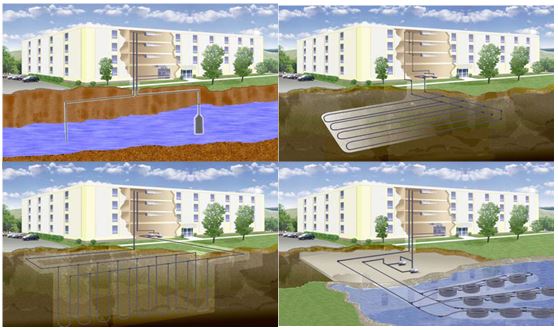HEAT PUMP
Heat transfer occurs always from a high-temperature environment to a low-temperature environment. This is a natural phenomenon which occurs spontaneously. The opposite cannot happen spontaneously. The transfer of heat from a low-temperature environment to a high-temperature environment can only occur with the use of heat pumps. A heat pump is simply an electrically-powered system that transfers heat energy from a low-temperature environment to a high- temperature environment.
Heat pumps operate on the basis of a refrigeration cycle. Heat is released as a result of a refrigeration process. If you are cooling an environment, it means that you are heating another environment.
Heat pumps can use various sources and are named according to the sources they use. Air, water, ground, a low-temperature geothermal water resource, hot or cold wastewater discharged from a process, or stored solar energy can also be used as a source of heat energy for a heat pump.
The term Ground-Source Heat Pump covers all the different systems that use shallow depths of the earth, groundwater and surface water as heat sources and heat wells. In addition, the term Geothermal Heat Pump is often used as well. This technology is based on the fact that temperature at a certain depth of the earth remains relatively constant throughout the year. The underground acts as a source of heat in winter and a heat sink in summer.
Heat pumps are used where geothermal water temperature or ambient temperatures in shallow depths are above normal, generally 10 - 32 oC. Conventional geothermal heating (and cooling) systems are not efficient at these temperatures. Heat pumps, on the other hand, can provide space heating and cooling and domestic water heating at these temperatures.
The source of heat energy is the sun's rays at a depth of a few meters under the ground, and geothermal heat flux at depths generally after 5-7 meters. Energy is carried up by groundwater through circulation (convection) or conduction from the depths of the earth (conductivity). In lakes, it is mainly sun rays. In this way, a higher-temperature source from the outdoor air during heating season and a lower-temperature receiving environment for cooling in summer are achieved.
Ground-Source Heat Pump offers the lowest CO2 emission and lowest total environmental cost among all technologies.
There are two main heat sources in Ground-Source Heat Pump systems: "Water" and "Shallow Depth Environments".
Lakes, large streams and groundwater aquifers can be used as significant sources of heat, as there is a constant temperature of 10-14 oC in their deeper parts, usually deeper than 3 meters.
The shallow depths of the earth are generally characterized by soil up to a few meters deep and rocky environments up to 150-200 meters deep, and these depths have a constant temperature of 12-18 oC.
Energy in environments can be conveyed to any place by laying pipes in lakes and large streams to circulate fluids that provide high heat transfer in these pipes, by obtaining water from wells drilled into groundwater aquifers, and by laying pipes into excavated or drilled soil or rocky environments to circulate fluids that provide high heat transfer in these pipes.
This energy is used in space heating and hot running water with devices called "Heat Pumps". Operating the system reverse, cooling can be achieved by moving the heat energy in spaces to the soil or rock environment or groundwater environment.
75% of the heat energy coming from a ground-source heat pump is obtained from the heat source, whereas the remaining 25% from electrical energy. Both heating and cooling can be done with a single device. Hot water can also be obtained by means of an additional device.
The initial investment cost of a ground-source heat pump system is 20-30% higher than a conventional heating / cooling system. However, its operation and maintenance costs are much lower than a conventional system.
A ground-source heat pump system can be applied anywhere and to a building of any type and size, if there is enough space.
